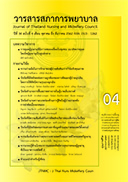Predictors of Functional Restoration in Extremity Injury Patients
Keywords:
functional restoration, severity of injury, ability of joint movement, acute delirium, limb injuryAbstract
Objective: To examine predictive powers of severity of injury, pain, ability of joint movement and delirium on functional restoration among extremity injury patients.
Design: Descriptive predictive study.
Methodology: The sample consisted of 85 extremity injury patients who had Abbreviated injury scale (AIS) score of 3 or higher, and Glasgow Coma Scale of 15. The patients were being treated at a selected hospital. The instruments used for data collection were a severity of injury assessment form, Short-form McGill Pain Questionnaire (Th-SFMPQ), degree of joint movement ability record form, Thai Delirium Rating Scale-Ramathibodi Hospital (TDRS-RH) Questionnaire, and Functional Restoration of Cumulate Ambulation Score (CAS) Questionnaire. Data were analyzed using Logistic regression, with the signifcant value set at 0.05.
Results: More than half of the participants (64.7%) were male, with an average age of 50.54 years (SD = 19.60), a moderate level of injury severity ( = 14.89±8.914) and a moderate ability of joint movement ( = 3.35±4.17). The top three organs with abnormal joint movements were the hips, the knees, and the ankles, respectively. The participants' average total pain score was 10.13 (SD = 7.48). Acute delirium was found in only three
participants. Most participants reported good functional restoration ( = 1.79±0.41). Only the severity of injury (OR = 3.326; 95%CI = 1.353-8.176, p < 0.001) and ability of joint movement (OR = 1.440; 95%CI = 1.139-1.821, p < 0.001) were able to jointly predict functional restoration for 64.7% of variance (R2 = .647, Chi square = 45.768, p < 0.001).
Recommendations: The fndings indicated that severity of injury and ability of joint movement influenced functional restoration in extremity injury patients. Therefore, physical rehabilitation must be a priority in patients with high injury severity level and abnormal joint movement, in order to promote recovery of functional restoration, and prevent possible complications caused by decreased joint movement.
Downloads
References
of injury correlate with long-term outcome in the severe traumatic patient. Rev Bras Anestesiol.
2014;64(2):134-9.
2. Mahdian M, Fazel MR, Sehat M, Khosravi G, Mohammadzadeh M. Epidemiological profle of
extremity fractures and dislocations in road traffc accidents in Kashan, Iran: a glance at the related disabilities. Arch Bone Jt Surg. 2017;5(3):186-92.
3. Parreira JG, Rondini GZ, Below C, Tanaka GO, Pelluchi JN, Perlingeiro JA, et al. Trauma mechanism
predicts the frequency and the severity of injuries in blunt trauma patients. Rev Assoc Med Bras. 2017; 44(4):340-7.
4. Nimthasanasiri A, Chayaput P, Thosingha O, Sanansilp V. Correlation between management of acute pain,
severity of injury, type of surgery and post-operative pain outcome in injured patients. Thai Journal of
Nursing Council. 2013;28(1):111-23. (in Thai)
5. Watcharadul Y. Orthopaedics history taking and examination. 3rd ed. Bangkok: Siriraj Book Publishing;
2522, pp. 13-66. (in Thai)
6. Khantejit K, Kasemkitwatana S, Chayaput P. Development of a clinical nursing practice guideline for prevention
of acute delilium in elderly undergoing gastrointestinal surgery. Thai J Nurs Counc. 2008;23(2):26-37. (in Thai)
7. Laytin AD, Kumar VK, Juillard CJ, Sarang B, Lashoher A, Roy N, et al. Choice of injury scoring system in
low- and middle-income countries: lessons from Mumbai. Int J Care Injured. 2015;46(1):2491-7.
8. Berben SA, Schoonhoven L, Meijs TH, van Vugt AB, van Grunsven PM. Prevalence and relief of pain
in trauma patients in emergency medical services. Clin J Pain. 2011;27(7):587-92.
9. Roy C, Bakan G, Li Z, Nguyen TH. Coping measurement: creating short form of Coping and Adaptation Processing
Scale using item response theory and patients dealing with chronic and acute health conditions. Appl Nurs Res. 2016;32(1):73-9.
10. Chayaput P, Utriyaprasit K, Bootcheewan S, Thosingha O. Coping and health problems of caregivers of survivors
with traumatic brain injury. Aquichan. 2014;14(2): 170-83.
11. Roy C. The Roy adaptation model. 3rd ed. Upper Saddle River (NJ): Pearson; 2008.
12. Pandharipande P, Cotton BA, Shintani A, Thompson J, Pun BT, Morris JA, et al. Prevalence and risk
factors for development of delirium in surgical and trauma ICU patients. J Trauma. 2008;65(1):34-41.
13. Dokov W, Radoinova D. Applicability of the abbreviated injury scale in forensic medical practice in bulgaria. Acta Medica. 2014;46(3):51-4.
14. Baker SP, O’neill B, Haddon W, Long WB. The Injury Severity Score: a method for describing patients with
multiple injuries and evaluating emergency care. J Trauma. 1974;14(3):187-96.
15. Jones JM, Skaga NO, Sovik S, Lossius HM, Eken T. Norwegian survival prediction model in trauma:
modeling effects of anatomic injury, acute physiology, age, and co-morbidity. Acta Anaesthesiol Scand. 2014;58(1):303-15.63
16. Kitisomprayoonkul W, Klaphajone J, Kovindha A. Thai Short-Form McGill Pain Questionnaire. J Med
Assoc Thai. 2006;89(6):846-53.
17. Melzack R, Wall PD, Ty TC. Acute pain in an emergency clinic: latency of onset and descriptor patterns related
to different injuries. Pain. 1982;14(1):33-43.
18. Hulsbaek S, Larsen RF, Rosthoj S, Kristensen MT. The Barthel Index and the Cumulated Ambulation Score are superior to the de Morton Mobility Index for the early assessment of outcome in patients with a hip fracture admitted to an acute geriatric ward. Disabil Rehabil. 2019;41(11):1351-59.
19. Foss NB, Kristensen MT, Kehlet H. Prediction of postoperative morbidity, mortality and rehabilitation
in hip fracture patients: the cumulated ambulation score. Clin Rehabil. 2006;20(1):701-8.
20. Zartrungpak S, Prasertchai R, Jennawasin S, Saipanish R. Validity of Thai delirium rating scale 6 items version.
Siriraj Med J. 2001;53(9):672-7. (in Thai)
21. Blackmore C, Ouellet JF, Niven D, Kirkpatrick AW, Ball CG. Prevention of delirium in trauma patients:
are we giving thiamine prophylaxis a fair chance? Can J Surg. 2014;57(2):78-81.
22. Wood E, Albarqouni L, Tkachuk S, Green CJ, Ahamad K, Nolan S, et al. Will this hospitalized patient develop severe alcohol withdrawal syndrome? The rational clinical examination systematic review. JAMA. 2018;320(8):825-33.
23. Osiezagha K, Ali S, Freeman C, Barker NC, Jabeen S, Maitra S, et al. Thiamine defciency and delirium.
Innov Clin Neurosci. 2013;10(4):26-32.








